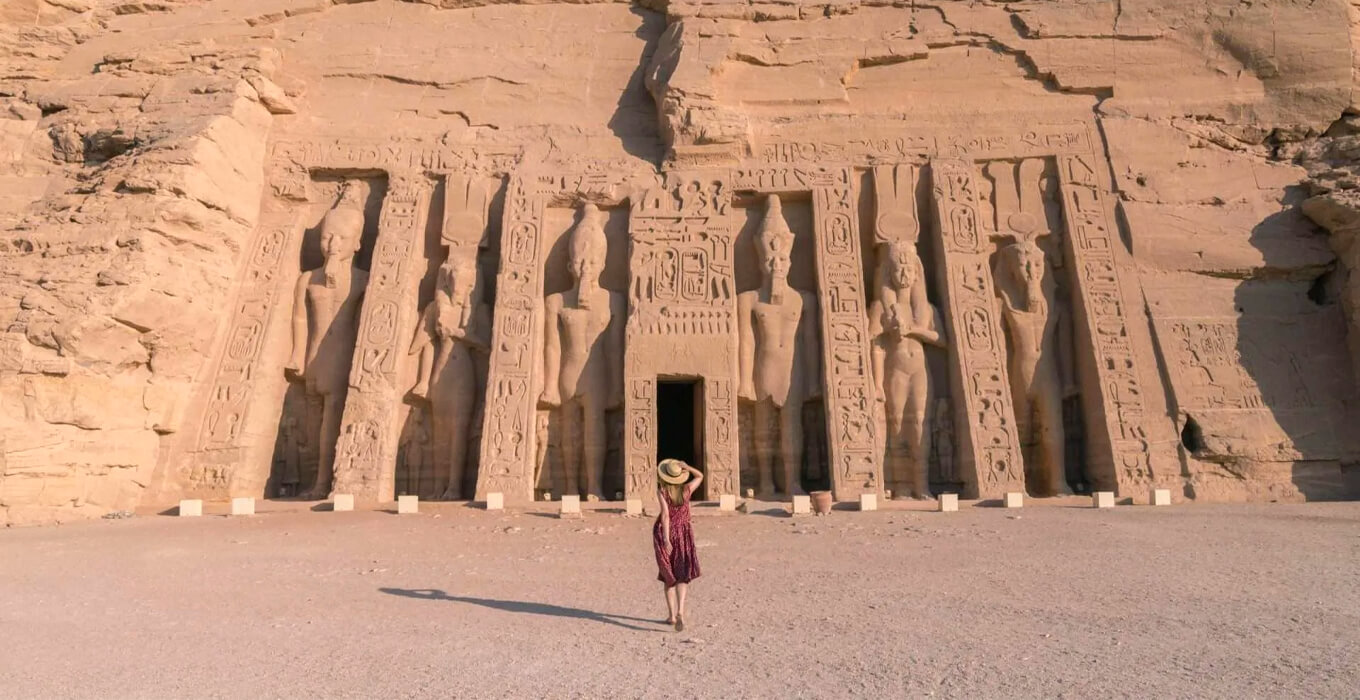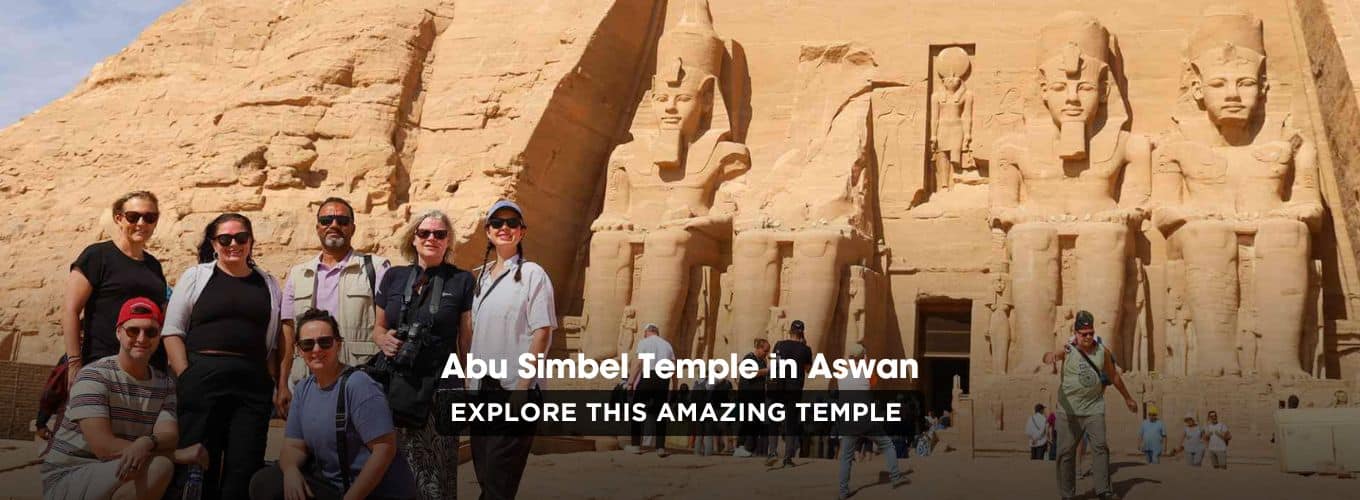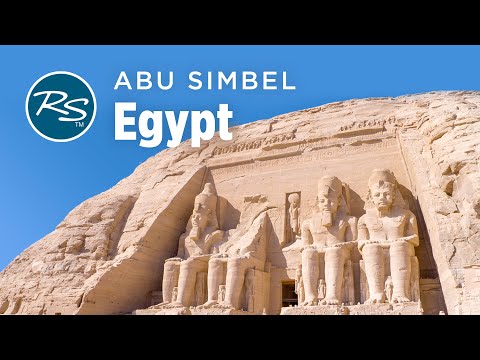Over 3,000 years ago, Pharaoh Ramesses II built the twin temples of Abu Simbel. They are a wonder of the ancient world. These huge rock-cut structures are on the banks of Lake Nasser in Aswan. They survived the Aswan High Dam‘s construction, which could have hidden them forever.
Visiting Abu Simbel lets you see the grandeur of ancient Egyptian architecture. You’ll learn about the legacy of a powerful Egyptian ruler.
Key Takeaways
- Abu Simbel is an iconic ancient Egyptian monument built over 3,000 years ago by Ramesses II.
- The twin temples were relocated in the 1960s due to the construction of the Aswan High Dam, showcasing an incredible engineering feat.
- Exploring Abu Simbel offers a chance to witness the impressive scale and intricate carvings of pharaonic architecture.
- Visiting the temples provides insight into the Nubian culture and the lasting impact of Ramesses II’s reign.
- Abu Simbel is a UNESCO World Heritage Site, making it a must-visit destination for those interested in ancient Egyptian history and Egyptology.
Discovering the Majestic Abu Simbel Temple in Aswan, Egypt
Location and History
The Abu Simbel temples sit 300 kilometers south of Aswan, near the Sudan border. They are on the western bank of Lake Nasser in Nubia. Ramesses II built the Great Temple over 3,000 years ago. It honors gods like Amon-Ra and shows Egypt’s power and Ramesses II’s glory.
The Small Temple is for Queen Nefertari, Ramesses II’s favorite wife.

Interesting Facts About Abu Simbel
Building the Abu Simbel temples took twenty years and ended in 1244 BC. They were forgotten and buried under sand. Swiss explorer Johann Ludwig Burckhardt found the temple in 1813.
Italian explorer Giovanni Battista Belzoni uncovered it four years later. The Aswan High Dam project moved the temples to safety. This huge effort involved over 50 countries and took five years.
- The Abu Simbel temples experience solar alignment twice a year on October 22 and February 22, allowing the sun’s rays to penetrate the sanctuary.
- The larger Temple of Ramesses II at Abu Simbel is a grand monument, standing at 20 meters tall with a façade of 33 meters in height and 38 meters across.
- The smaller Temple of Hathor and Nefertari at Abu Simbel features six colossal statues flanking the entrance and a grand hall with pillars.
“The Abu Simbel temples were built in the 13th century BC by Pharaoh Ramesses II and dedicated to himself and his queen Nefertari.”
How to Get to Abu Simbel Temple
Visiting the amazing Abu Simbel temple in Aswan, Egypt, has several ways to get there. The quickest way is by flying from Aswan to Abu Simbel, which is about 45 minutes. Egypt Air is the only airline for this route, with flights twice a day. They offer a shuttle, called the “Happy Year Transport,” from the airport to the temple.
This flight gives you about 1.5 hours to see the temples before heading back to Aswan.
If flying isn’t your choice, you can drive from Aswan to Abu Simbel. The trip is around 290 km and takes 2.5 to 3 hours. Many Aswan hotels offer a day trip to Abu Simbel by car, lasting about 8 hours.
You can also hire a private driver for the trip. This costs between 3,500 and 3,800 EGP for a roundtrip.
|
Transportation Option |
Duration |
Cost |
|
Roundtrip Flight from Aswan |
45 minutes one-way |
Starting from 70 USD per person |
|
Private Transfer from Aswan |
2.5-3 hours one-way |
1,400 EGP (70 USD) per car, including a 300 EGP tip |
|
Group Tour from Aswan |
8 hours roundtrip |
Starting from 29 USD per person |
No matter how you get there, visiting the Abu Simbel temple in Aswan, Egypt, is unforgettable.
Visiting Abu Simbel Temple When Flying Between Cairo and Aswan
Visiting the Abu Simbel Temple is easy when flying between Cairo and Aswan. You can book a flight with a stop at Abu Simbel. This lets you see the ancient wonder during your trip. But remember, all flights to Abu Simbel go through Aswan. Your checked luggage stays at Aswan airport until you return.
So, think about what you can carry on when going to the temple. You’ll only have your carry-on items with you. Plan and pack well to make your Abu Simbel stopover smooth.
|
Tour Price Range for Aswan & Abu Simbel Tour from Cairo |
Note: Children will be charged 50% of the Adult prices for the tour. The tour company offers customized tours for large groups over 16 participants. Payment options include a monthly payment plan. |
Adding an Abu Simbel stopover to your Cairo-Aswan flights is easy. You won’t need extra transport to see this amazing place. Just remember about your luggage, and you’re set for a memorable visit to the Abu Simbel Temple.
Our Experience: Flying Round Trip from Aswan
We decided to fly roundtrip from Aswan to visit the Abu Simbel Temple in Egypt. This choice was easy and saved us time for our Abu Simbel day trip.
The flight costs from Aswan were the same as going via Cairo. Flying back to Aswan meant we could keep our valuables safe at our hotel. We didn’t have to carry them or leave them on the bus.
We had already driven a lot, so flying was a nice break from land transportation. The whole trip from Aswan took about 7 hours. This let us see the temple at a good pace.
|
Tour Details |
Value |
|
Duration of the tour |
About 6 hours |
|
Number of countries visited |
1 |
|
Type of tour |
Private tour |
|
Tour availability |
Everyday |
|
Pricing structure for the tour |
|
|
Number of reviews |
3 |
|
Average rating based on reviews |
5 stars |
Flying roundtrip from Aswan for the Abu Simbel day trip was a smart choice. It let us enjoy the temple’s beauty without the long drive.
Abu Simbel Temple in Aswan, Egypt: What to Expect
Getting to the Temple Complex
When you arrive at the Abu Simbel temple complex in Aswan, Egypt, you’ll see something amazing. The trip to the site is an adventure itself. You can walk down for 5 minutes to the complex or use an electric buggy if you like.
As you get closer, you’ll see the Great Temple and Temple of Hathor. They look incredible and make you excited for what’s ahead.
If you flew in, there’s a free shuttle from the airport to the temple. It makes starting your Abu Simbel trip easy and worry-free.
|
Arrival Method |
Travel Time |
Transportation Options |
|
By Plane |
45-minute flight from Aswan |
Egypt Air “Happy Year Transport” shuttle bus |
|
By Road |
Approximately 3-hour drive from Aswan |
Private car, tour bus, or self-drive |
|
By Boat |
As part of a Lake Nasser cruise |
Cruise ship or boat tour |
As the temple comes into sight, you’ll feel excited and curious. You’re ready to dive into the history and beauty of the Abu Simbel temple in Aswan, Egypt.
The Remarkable History of Abu Simbel Temple
The Abu Simbel temples are 240 kilometers from Aswan, Egypt. They show the greatness of ancient Egyptian civilization. Built over 3,000 years ago by Pharaoh Ramesses II, they highlight the empire’s power and dreams.
The Great Temple was for gods Amon-Ra, Ra-Harakhti, and Ptah. It also honored Ramesses II’s glory. The smaller temple was for Queen Nefertari, Ramesses II’s dear wife. It showed the Pharaoh’s love for her and Nubian culture.
These temples were forgotten and buried under sand. They were found again in the early 1800s. But, the Aswan High Dam in the 1960s could have destroyed them. So, people worked hard to move the temples to safety.
“The effort-consuming task of relocating Abu Simbel is considered one of the most difficult relocations ever.”
The move took four years. Workers cut the temples into big blocks and moved them 200 meters up. This saved the ancient sites. The temples were reopened on September 22, 1968.
Now, the Abu Simbel temples draw visitors from all over. They remind us of Ramesses II‘s legacy and the Nubian culture of old Egypt.
Experiencing Abu Simbel Temple at Night
Visiting the majestic Abu Simbel temples at night is amazing. As the sun goes down, the temples light up. This creates a magical glow over the area.
The Sound and Light Show
The Sound and Light Show is a big part of the night visit. It shows images on the temples with a story. This tells about the site’s history and importance.
The show is a bit old, but it’s special. It lets visitors see the temples in a unique way. The temples get lit up, showing off their details and big statues.
The story tells about Ramses II, the pharaoh who built the temples. It talks about the challenges to save them when the Aswan High Dam was built.
After the show, you can see the temples by yourself. The night sky makes them look even bigger and more beautiful. Walking through the dim halls is amazing.
“The Abu Simbel Sound and Light Show was a truly unforgettable experience. The way the temples were illuminated under the night sky was simply magical. It brought the site’s history to life in a way that was both informative and deeply moving.”
Going to Abu Simbel at night is a must for travelers to Egypt. The temples light up, the night is calm, and you get to dive into the site’s history and culture. It’s an experience you won’t forget.
Travel Tips for Visiting Abu Simbel Temple

Planning a trip to Abu Simbel Temple in Aswan, Egypt needs careful thought. You’ll want to think about the best way to get there, how much it costs, and how to take great photos. These tips will make your visit smooth and unforgettable.
Transportation and Timing
The road to Abu Simbel opens from 5 am to 5 pm. This means you can’t visit at sunrise or sunset. To make the most of your time, think about a private car tour from Aswan. It costs about 2000 EGP (115 EUR or 130 USD) for a round trip.
You could also fly from Aswan, Cairo, or Luxor. This might be more expensive but quicker.
Entrance Fees and Discounts
Adults pay 200 EGP to enter Abu Simbel. But, students with ID pay half price, at 100 EGP. A camera pass is 300 EGP, and a guide ticket is 15 EGP. Don’t forget your student ID for the discount.
Photography Tips
Photographers love Abu Simbel for its beautiful hieroglyphics and big statues of Ramses II. Flash is okay during the Sound and Light Show but can bother others. Try to take photos in the late morning for the best light.
Accommodation and Dining
There are not many places to stay close to Abu Simbel. You can choose from budget hotels like Hotel Safari Abu Simbel or the Seti Abu Simbel Lake Resort. Staying over lets you see the temple at sunrise or enjoy the Sound and Light Show.
For food, options are simple. It’s smart to pack snacks and water.
Keep these tips in mind for a great visit to Abu Simbel Temple. You’ll leave with unforgettable memories of this ancient site.
Conclusion
The Abu Simbel temples show us the amazing work of ancient Egyptian civilization. They give us a peek into the history and culture of Pharaoh Ramses II. The huge statues at the Great Temple and the special way the sun moves are still amazing today.
Visitors can explore the temple’s inside, learn about its move, or see the sound and light show. This makes people appreciate Egypt’s rich past more.
Planning your visit well lets you enjoy Abu Simbel fully. You can go for a day trip from Aswan or stay overnight. The temples offer a deep dive into ancient Egypt’s history and architecture.
Abu Simbel is a place where nature and human work meet. It’s a top spot for those wanting to learn about the Nile Valley’s secrets.
The Abu Simbel temples remind us of Pharaonic Egypt’s lasting impact. They invite us to travel back in time. By seeing Abu Simbel, we learn more about the area’s history and admire ancient Egypt’s great achievements.
Read our related articles:


